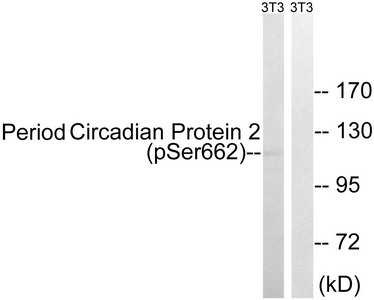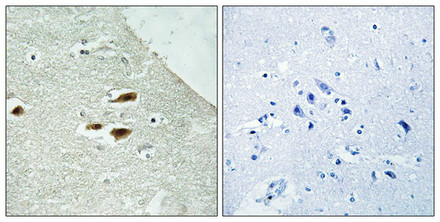
Western blot analysis of extracts from 3T3 cells, treated with PMA (125ng/ml, 30mins), using Period Circadian Protein 2 (Phospho-Ser662) antibody. The lane on the right is treated with the synthesized peptide.
Phospho-PER2 (Ser662) Antibody
CSB-PA217277
ApplicationsWestern Blot, ELISA, ImmunoHistoChemistry
Product group Antibodies
ReactivityHuman, Mouse
TargetPER2
Overview
- SupplierCusabio
- Product NamePhospho-PER2 (Ser662) Antibody
- Delivery Days Customer20
- ApplicationsWestern Blot, ELISA, ImmunoHistoChemistry
- CertificationResearch Use Only
- ClonalityPolyclonal
- ConjugateUnconjugated
- Gene ID8864
- Target namePER2
- Target descriptionperiod circadian regulator 2
- Target synonymscircadian clock protein PERIOD 2; FASPS; FASPS1; hPER2; period 2; period circadian clock 2; period circadian protein 2; period circadian protein homolog 2; period homolog 2
- HostRabbit
- IsotypeIgG
- Protein IDO15055
- Protein NamePeriod circadian protein homolog 2
- Scientific DescriptionTranscriptional repressor which forms a core component of the circadian clock. The circadian clock, an internal time-keeping system, regulates various physiological processes through the generation of approximately 24 hour circadian rhythms in gene expression, which are translated into rhythms in metabolism and behavior. It is derived from the Latin roots circa (about) and diem (day) and acts as an important regulator of a wide array of physiological functions including metabolism, sleep, body temperature, blood pressure, endocrine, immune, cardiovascular, and renal function. Consists of two major components: the central clock, residing in the suprachiasmatic nucleus (SCN) of the brain, and the peripheral clocks that are present in nearly every tissue and organ system. Both the central and peripheral clocks can be reset by environmental cues, also known as Zeitgebers (German for timegivers).
- ReactivityHuman, Mouse
- Storage Instruction-20°C or -80°C
- UNSPSC12352203


